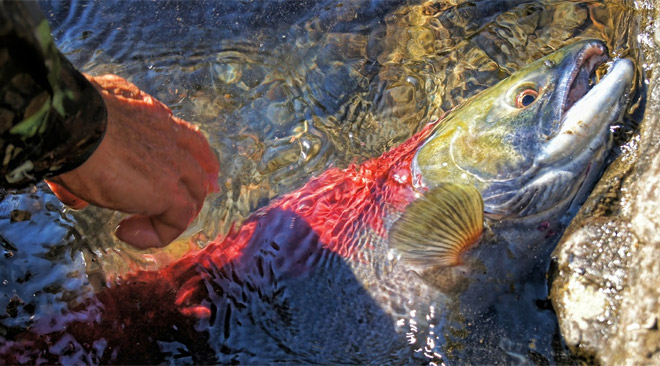By Dr. Mike Pearson –
The Fraser River Sockeye returns of 2017 were the lowest since recording began 124 years ago. Indeed, over half of Fraser Sockeye stocks – 15 of 24 – were recently listed as species at risk by the scientific body responsible for assessments. Eight of them were classified Endangered, defined as ‘at imminent risk of extinction’.

The Committee on the Status of Endangered Wildlife in Canada (COSEWIC) made the assessments at its November 2017 meeting using a rigorous, peer reviewed assessment process. In accordance with Canada’s Species at Risk Act (SARA), the committee will now forward its list to the federal government for Cabinet to decide whether to protect them under the Act.
If the past is any guide, however, Cabinet will refuse to list any of them under SARA. Of the 62 commercially fished species that have been listed by COSEWIC in the past, only 12 have been legally protected—and they do not include the two Sockeye stocks listed as endangered since 2002; those of Cultus Lake (near Chilliwack) and Sakinaw Lake (Sunshine Coast). According to the Department of Fisheries and Oceans’ (DFO), “In January 2005, a final decision was made by the Government of Canada to not list Cultus Lake Sockeye salmon under the Species at Risk Act (SARA), due to the significant socio-economic impacts on Sockeye fishers and coastal communities.” (http://www.dfo-mpo.gc.ca/species-especes/profiles-profils/cultus-sockeyesalmon-saumonsockeye-eng.html).
Listing endangered Sockeye stocks under SARA would indeed have major impacts on commercial, recreational, and Indigenous fisheries. It would immediately become illegal to “kill, capture or harass” fish from listed stocks. The problem is that all those endangered Sockeye are mixed in with fish from healthier stocks at sea and during migration, and there is no way of telling who is who at the time they are caught.
For example, if the large Sockeye run we are all hoping for in 2018 materializes, DFO may decide that 50 per cent of them can be fished. Loss of that proportion of fish for a big stock may well be sustainable in that there would still be enough reaching the spawning grounds to fill the habitat to capacity. That same percentage removed from an endangered stock, however, would decimate it.
The only way around this is to fish only in the spawning tributaries that support healthy stocks (so-called terminal fisheries) rather than in the ocean or along the migration route, where most of the fishing currently occurs. The impacts on downriver First Nations, the commercial fleet, and recreational anglers, however, would be enormous.
Why does it matter if we lose a few small stocks? Can’t we just focus on keeping the large ones healthy? The problem here is that each stock is uniquely adapted to its watershed and represents an irreplaceable part of the species’ genetic diversity. That diversity is what allows species to adapt to environmental change, such as the warmer water temperatures and changes in river flow patterns that have already started. For example, COSEWIC reports that the Cultus Lake Sockeye are irreplaceable because of their unique genetic and biological characteristics. These include, early arrival for spawning, a long adult holding period in the lake, spawning within the lake rather than in tributary rivers, and deep water use by fry. Some of these traits may well be helpful for the fish in coping with the impacts of global warming. We don’t know for sure, and if they are driven to extinction, we never will.
Canada has a constitutional obligation to Indigenous peoples to uphold their right to fish. Surely that includes managing fisheries in a way that ensures there are fish to catch. DFO can issue permits under SARA for activities that do not threaten the survival or recovery of an endangered or threatened stock. Perhaps this could be used to permit openings for Indigenous food and cultural needs.
Nor is this situation a one-off. COSEWIC is about to complete an emergency assessment on interior Steelhead, which is also likely to produce another endangered designation, and a new quandary for Cabinet. Many of these Steelhead are dying after being caught as by-catch in the Chum salmon fishery.
The upshot is there are no easy solutions but one thing is certain. Fisheries management needs to be far more precautionary than it has been. We are on the cusp of losing much of the genetic and life history diversity that exists in Sockeye and other salmonids in the Fraser watershed. Without that diversity, they lose their ability to withstand the stresses of warmer waters, new diseases, and whatever other challenges our rapidly changing environment presents.
Dr. Mike Pearson is a biologist based in Agassiz, BC. His consulting firm, Pearson Ecological, specializes in aquatic species at risk, habitat restoration, and ecological monitoring.
For a more detailed version of COSEWIC Wildlife Species Assessments visit: https://www.canada.ca/en/environment-climate-change/services/committee-status-endangered-wildlife/assessments/detailed-version-november-2017.html

